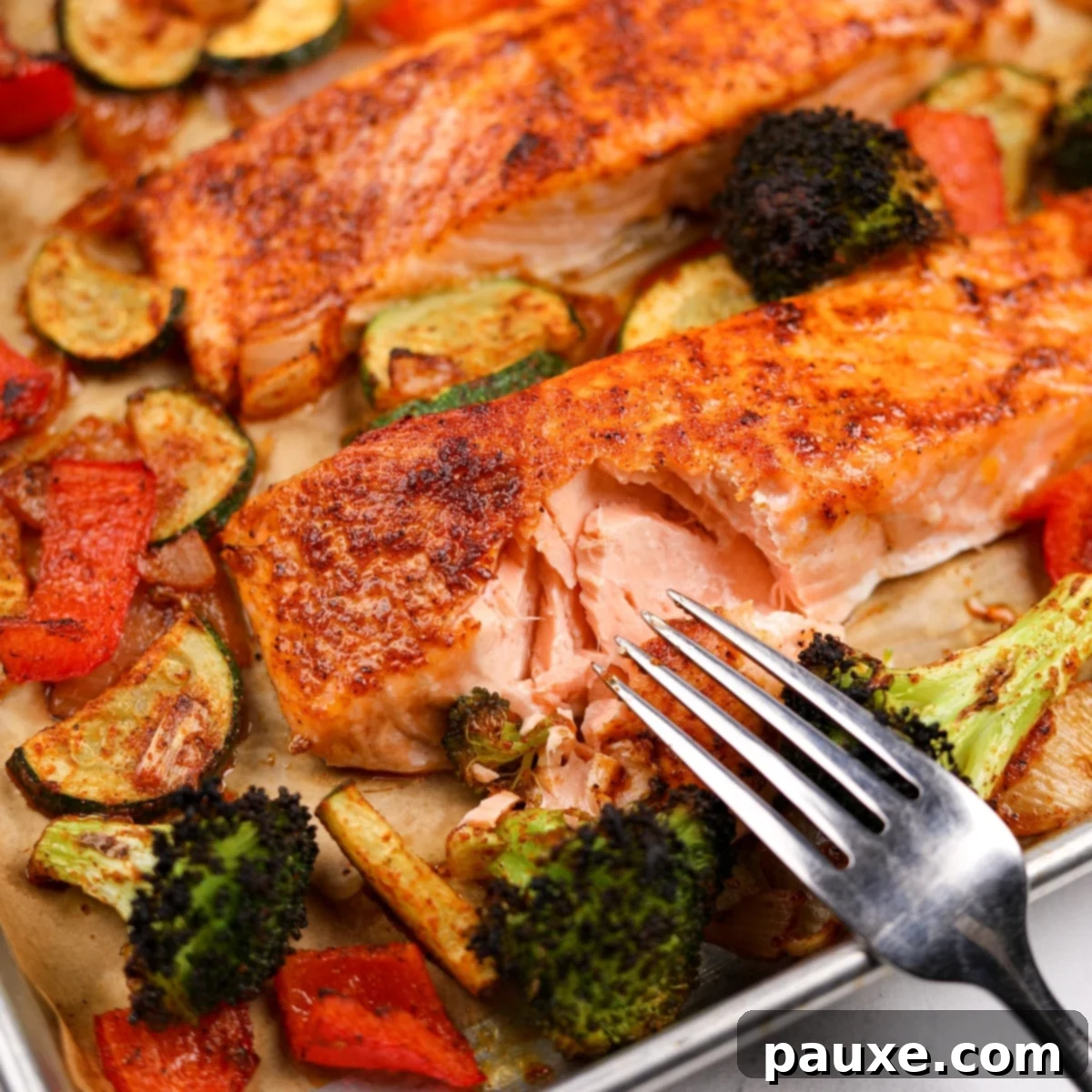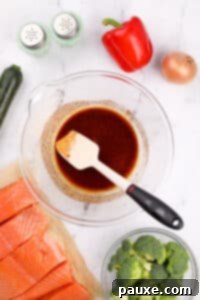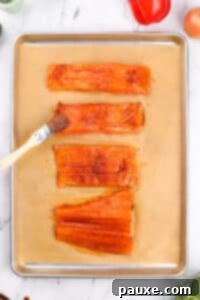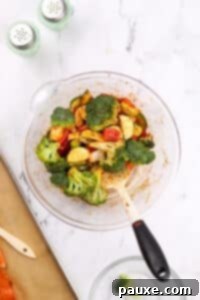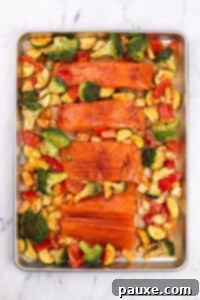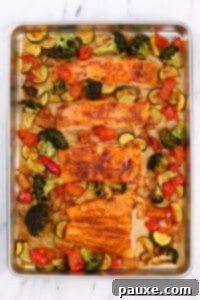Welcome to your new favorite weeknight warrior: this incredibly easy and undeniably delicious Sheet Pan Salmon and Veggies recipe! Designed for maximum flavor with minimal effort, this healthy dinner solution brings together succulent salmon fillets with a vibrant medley of crisp-tender broccoli, colorful bell pepper, and fresh zucchini. It’s a naturally low-carb, gluten-free, and dairy-free meal that doesn’t compromise on taste, making it perfect for families seeking nutritious and convenient options.
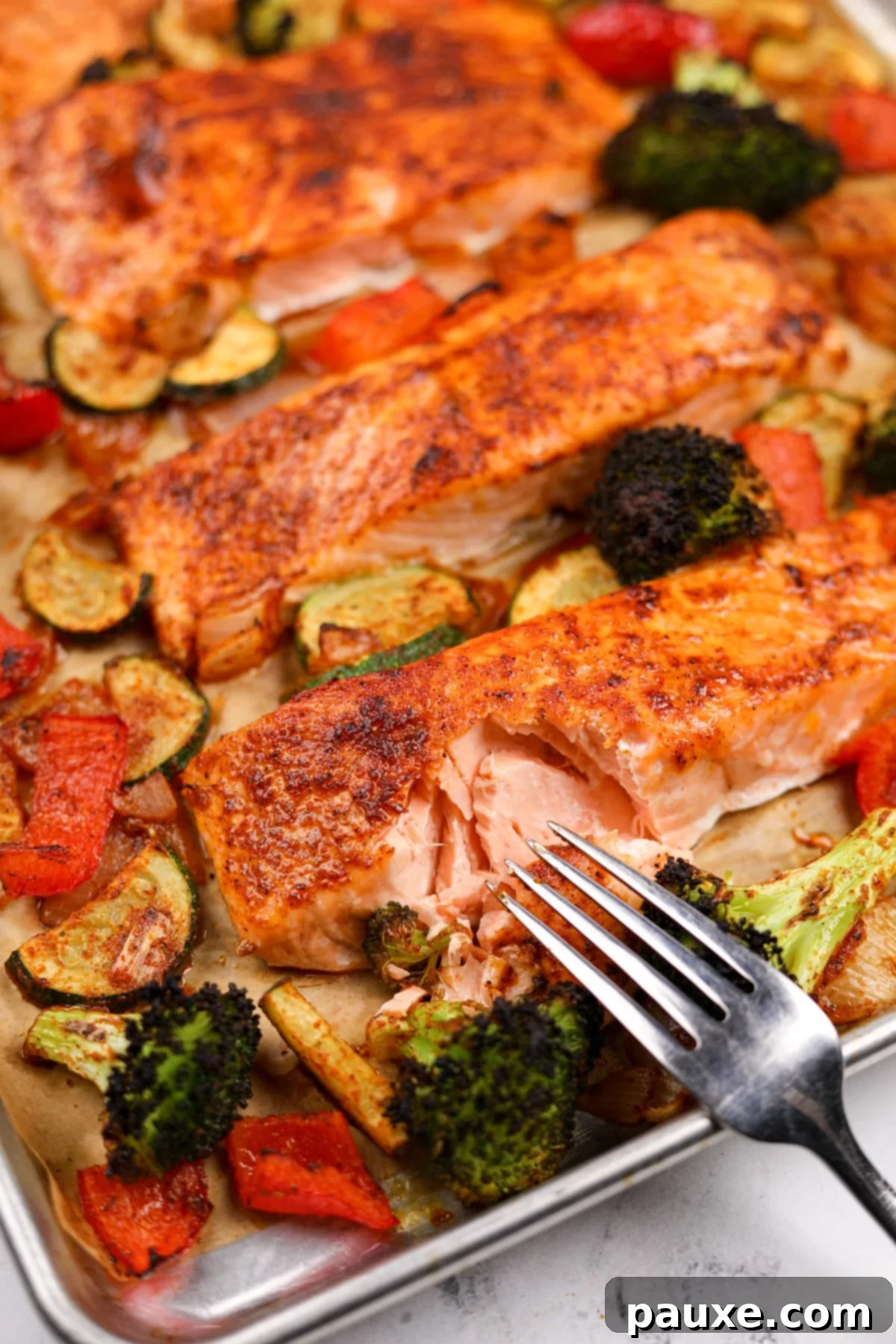
Incorporating salmon into our weekly meal rotation is a goal many of us share, often aiming for at least one serving to reap its impressive health benefits. What makes this aspiration easily achievable for me, and countless others, are sheet pan recipes. They simplify the cooking process, consolidating everything onto a single baking sheet, which means less time spent in the kitchen and more time enjoying your meal.
Following the success of our beloved sheet pan cilantro lime salmon recipe, we’re thrilled to introduce a fresh variation that highlights the versatility of sheet pan cooking: salmon paired with a delightful array of seasonal vegetables. This particular recipe stands out not only for its simplicity but also for its depth of flavor, creating a satisfying and complete meal that can be enjoyed on its own, or beautifully complemented by a side of hot cooked rice, roasted potatoes, fluffy quinoa, or even a refreshing salad.
Why You’ll Adore This Sheet Pan Salmon Recipe
This Sheet Pan Salmon and Veggies recipe isn’t just another dinner idea; it’s a game-changer for busy households and health-conscious eaters alike. Here are some compelling reasons why this dish is poised to become a staple in your culinary repertoire:
- Effortless Clean-Up: The magic of sheet pan meals truly shines when it comes to post-dinner tidying. By cooking all ingredients on a single baking sheet lined with parchment paper, you dramatically reduce the number of dishes. In most cases, a quick rinse of the pan is all that’s needed, virtually eliminating the need for arduous scrubbing. Say goodbye to piles of pots and pans!
- Nutrient Powerhouse: This meal is a symphony of essential nutrients. Salmon, renowned for its rich content of Omega-3 fatty acids, supports heart health and brain function. Paired with fiber-rich vegetables like broccoli, bell pepper, and zucchini, you get a balanced meal packed with vitamins, minerals, and antioxidants. It’s a wholesome option that provides sustained energy and keeps you feeling satisfied.
- Ideal for Busy Weeknights: Life gets hectic, but dinner doesn’t have to be complicated. With minimal prep work and a quick cooking time of just 10-14 minutes, this sheet pan salmon dinner is perfect for those evenings when time is of the essence. You can have a delicious, home-cooked meal on the table faster than ordering takeout, making it an invaluable addition to your weeknight rotation.
- Incredibly Versatile: One of the greatest strengths of this recipe is its adaptability. Feel free to customize it based on your preferences or whatever fresh produce you have on hand. Swap out the suggested vegetables for asparagus, green beans, cherry tomatoes, or sweet potatoes. For a different protein, chicken, shrimp, or even beef strips can be substituted, making this recipe endlessly repeatable without ever feeling repetitive.
- Dietary Friendly: Naturally low in carbohydrates, gluten-free, and dairy-free, this recipe caters to a variety of dietary needs and preferences. It’s a fantastic choice for those following specific eating plans, without sacrificing flavor or enjoyment.
Gather Your Ingredients for Success
The beauty of this recipe lies in its simple yet flavorful ingredient list. Quality fresh ingredients will truly elevate your dish. Here’s a closer look at what you’ll need and some tips for selection:

- Salmon Fillets: You’ll need four individual salmon fillets, ideally pre-cut and weighing approximately 6 ounces each (totaling 1-1.5 pounds). If using frozen salmon, ensure they are thoroughly thawed before cooking to promote even cooking with the vegetables. You can choose to leave the skin on or remove it; while salmon skin can get crispy when pan-seared, it tends to become less so during sheet pan roasting due to the steam from the vegetables. Removing it can be a personal preference, but it’s not strictly necessary. Wild-caught salmon often boasts a richer flavor and higher Omega-3 content compared to farmed varieties.
- Broccoli Florets: Approximately 2 cups of broccoli florets are perfect for this recipe, which typically comes from about one medium bunch of broccoli. You can chop them directly from the stalk or opt for pre-cut florets for added convenience. Ensure they are cut into bite-sized pieces for consistent roasting.
- Bell Pepper: One red bell pepper is recommended for its vibrant color and sweet flavor, which beautifully contrasts with the other ingredients. However, any color of bell pepper—yellow, orange, or green—will work wonderfully and provide essential vitamins. Chop it into roughly 1-inch pieces.
- Zucchini: Select one small zucchini or yellow squash. Smaller zucchinis generally have more concentrated flavor and fewer seeds, leading to a better texture once roasted. Cut it into half-moon shapes, about ¼-inch thick, to ensure it cooks evenly alongside the other vegetables without becoming mushy.
- Onion: A basic yellow onion provides a robust flavor base, softening and sweetening as it roasts. For a slightly milder and more visually appealing option, red onion is an excellent alternative. Roughly chop the onion into pieces similar in size to your bell pepper.
- Olive Oil: Extra virgin olive oil is preferred for its rich, fruity flavor and health benefits. It acts as a binder for the seasonings and helps the vegetables caramelize beautifully. If you prefer a more neutral-tasting oil or are cooking at higher temperatures, avocado oil is a great alternative due to its high smoke point.
- Lemon Juice: Freshly squeezed lemon juice will always offer the brightest, most vibrant flavor. However, high-quality bottled lemon juice can be used as a convenient substitute without compromising the dish significantly. It adds a crucial touch of acidity that brightens the entire meal.
- Seasonings: A simple yet effective blend of paprika, garlic powder, salt, and black pepper is all you need. Paprika adds a subtle smoky depth and beautiful color, while garlic powder provides that essential savory aroma. Adjust salt and pepper to your taste, remembering that fish and vegetables benefit from a good seasoning.
For a comprehensive list of exact quantities and precise measurements, please refer to the detailed recipe card below.
Essential Equipment for a Seamless Experience
One of the many charms of sheet pan dinners is the minimal equipment required. For this recipe, you really only need one key item, with a few optional additions that can enhance your cooking experience:
- Half-Size Sheet Pan: This is the hero of our recipe! A standard half-size sheet pan (approximately 18×13 inches) provides ample space for the salmon and vegetables to cook in a single, even layer. This is crucial for proper roasting and browning; overcrowding the pan can lead to steaming instead of roasting, resulting in soggy vegetables. You can easily find these versatile pans at almost any department store, kitchen supply shop, or online.
- Parchment Paper or Aluminum Foil: Essential for easy cleanup and preventing sticking. Parchment paper is highly recommended as it creates a non-stick surface and helps prevent food from burning. If you don’t have parchment paper, heavy-duty aluminum foil can be used, but be sure to lightly grease it with cooking spray or a little extra olive oil to prevent the fish and veggies from sticking.
- Large Mixing Bowl: You’ll need a spacious bowl to combine the vegetables with the seasoning and oil, ensuring everything is evenly coated.
- Pastry Brush: While not strictly essential, a pastry brush makes it incredibly easy to spread the seasoned oil mixture evenly over the salmon fillets.
- Sharp Knife and Cutting Board: For efficient and safe preparation of your vegetables.
- Meat Thermometer: The best way to ensure your salmon is cooked to perfection and safe to eat. An instant-read thermometer will give you accurate readings quickly.
Step-by-Step Cooking Guide
This sheet pan salmon recipe is incredibly straightforward to prepare, yielding a meal that is not only bursting with flavor but also rich in fiber and protein. Get ready to add this to your regular dinner rotation!
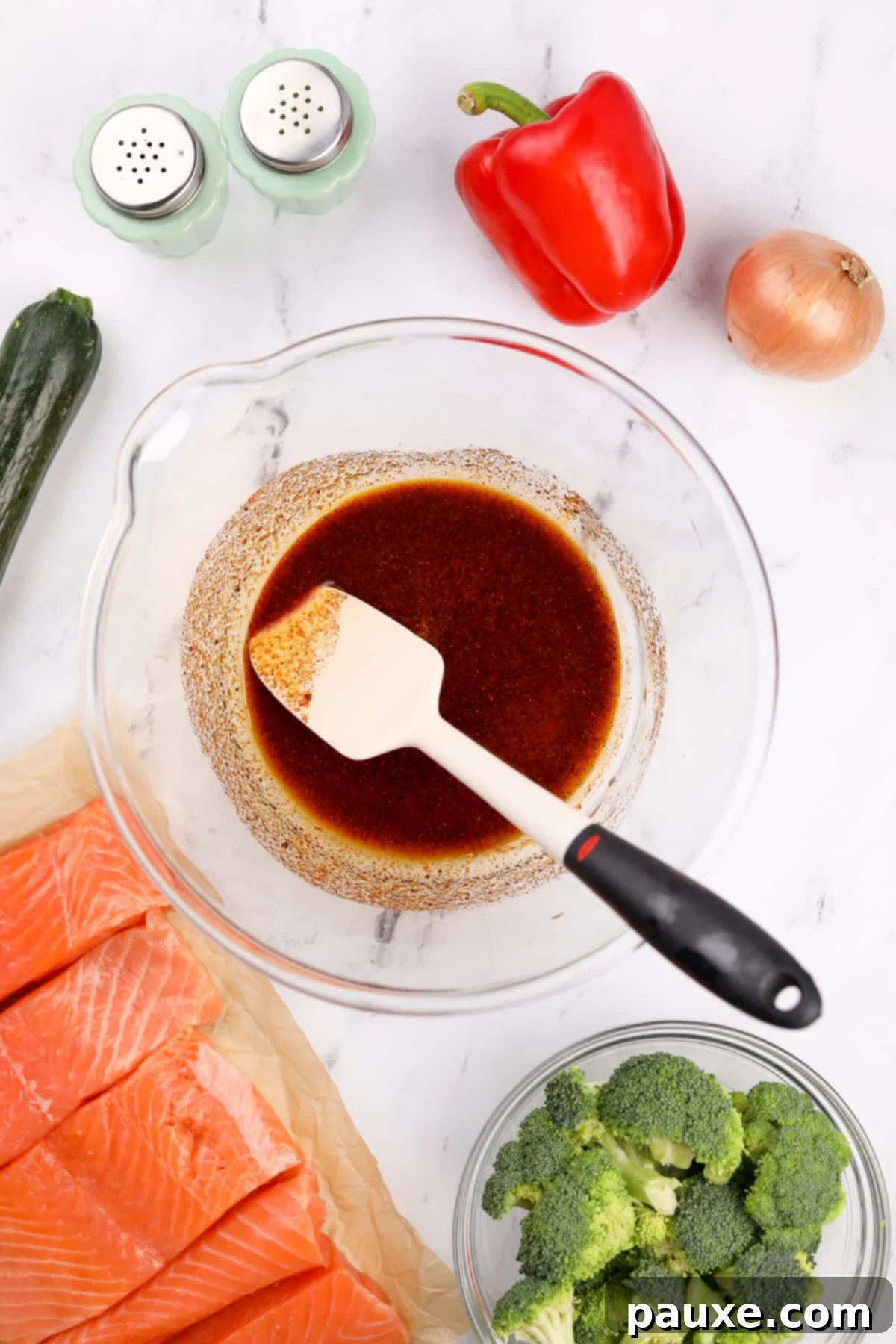
Step One: Prepare the Seasoning Mixture. In a large mixing bowl, combine the olive oil, fresh lemon juice, paprika, garlic powder, salt, and black pepper. Whisk these ingredients together thoroughly until they are well combined, creating a fragrant and flavorful oil mixture that will coat your salmon and vegetables.
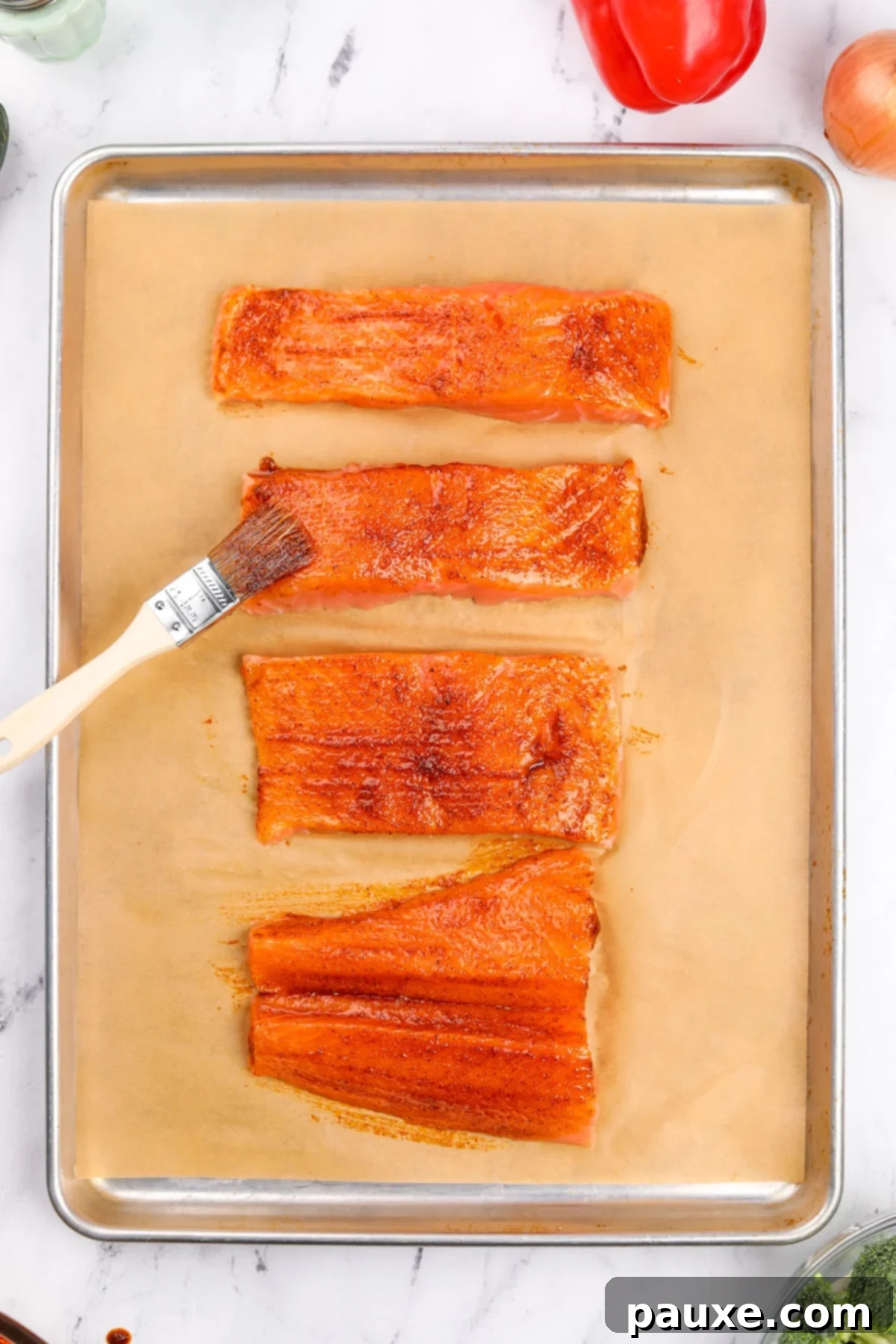
Step Two: Season the Salmon. Line a half-size sheet pan with parchment paper for easy cleanup. Arrange the salmon fillets, skin side down (if leaving skin on), on the prepared sheet pan, ensuring they are spaced out evenly. Using a pastry brush or the back of a spoon, spread approximately half of the prepared seasoned oil mixture generously over the top of each salmon fillet. Set the pan aside.
Adding the Vegetables
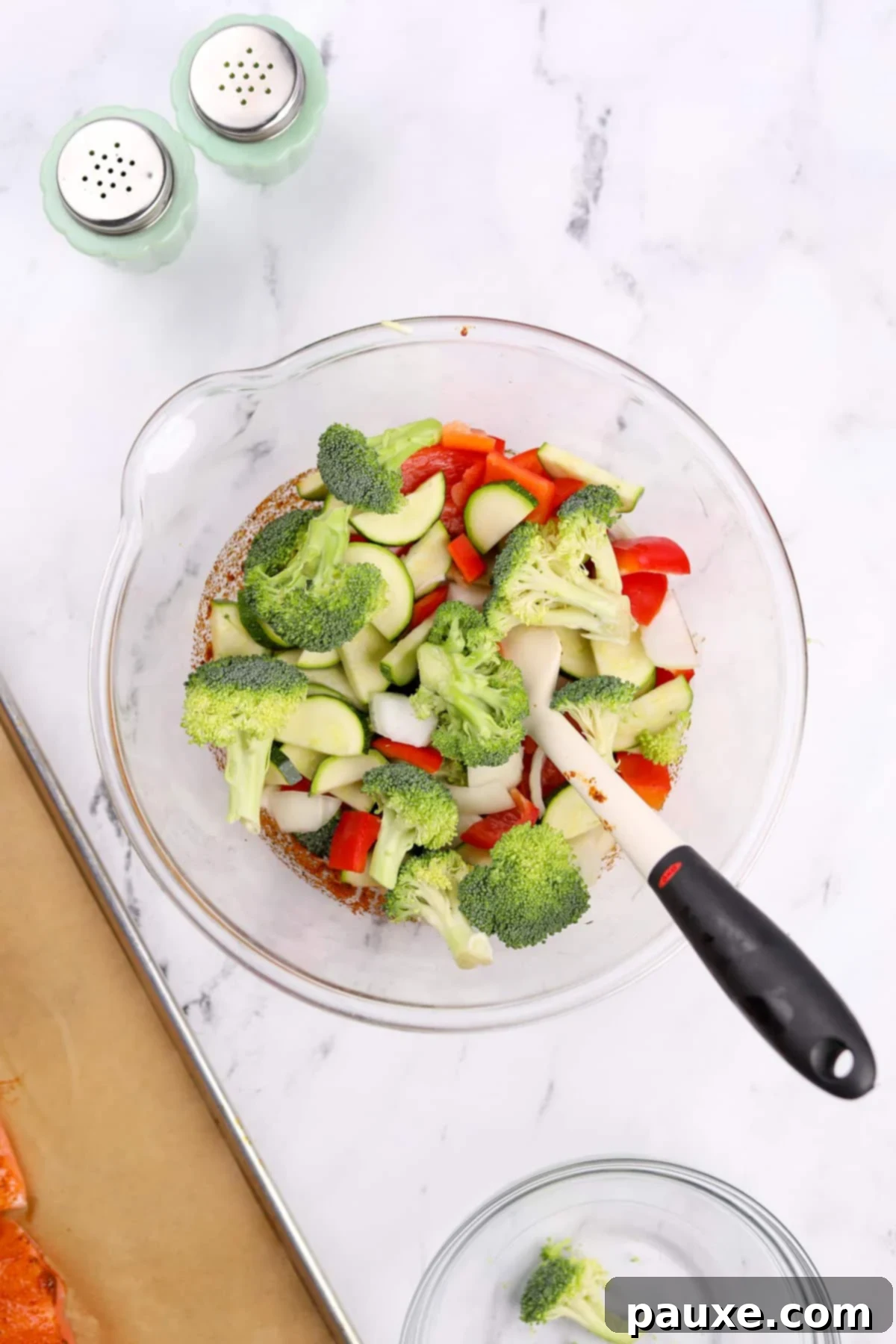
Step Three: Combine Vegetables and Remaining Seasoning. To the same large bowl containing the remaining seasoned oil mixture, add your prepared vegetables: the chopped broccoli florets, diced bell pepper, sliced zucchini, and roughly chopped onion. Ensure all vegetables are cut into similar, bite-sized pieces to promote uniform cooking.
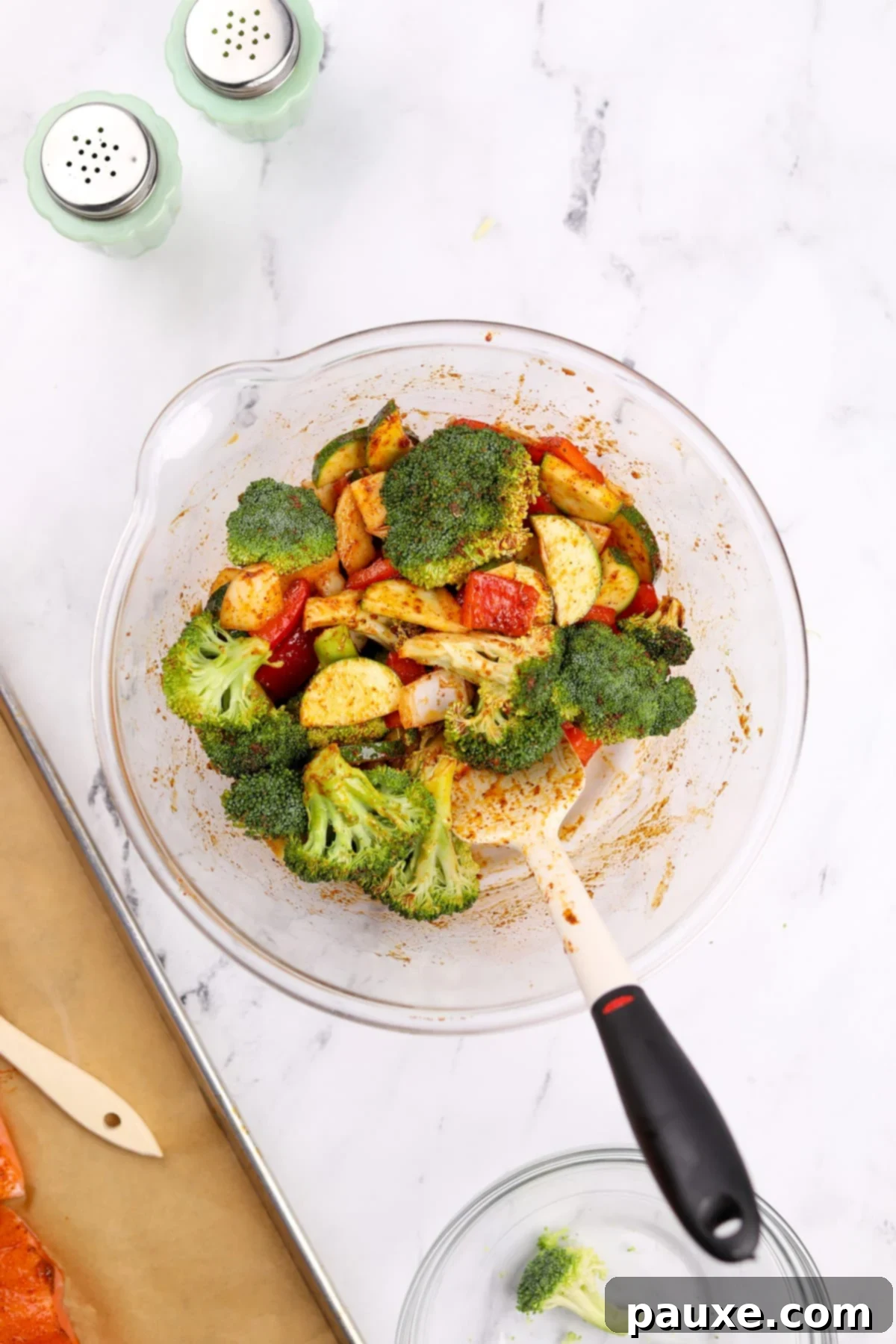
Step Four: Coat the Vegetables. Toss the vegetables thoroughly in the bowl until every piece is lightly and evenly coated with the delicious seasoning and oil mixture. This ensures maximum flavor and helps them achieve that desirable roasted texture.
Cooking to Perfection
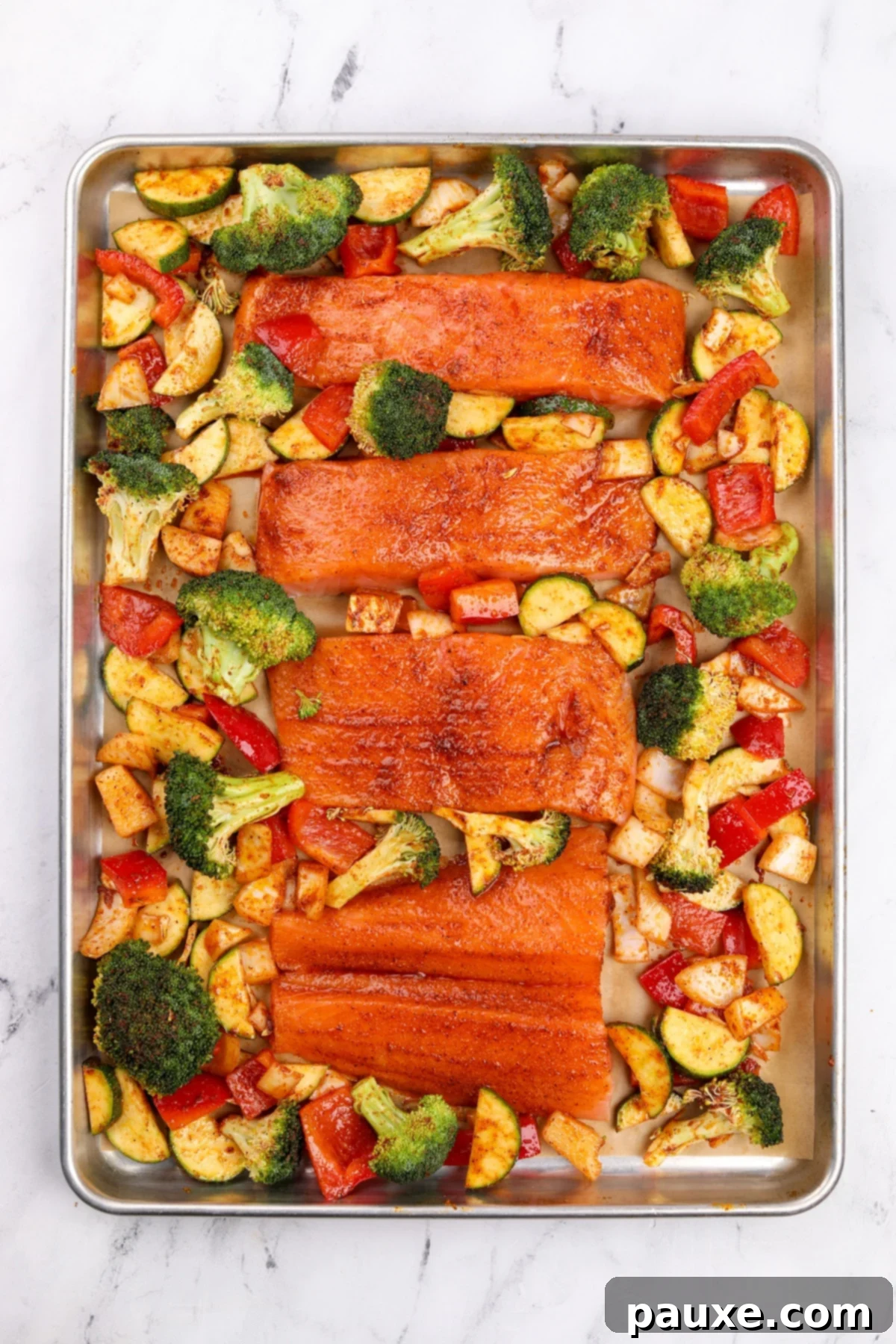
Step Five: Arrange on the Sheet Pan. Preheat your oven to a high broil setting. Carefully transfer the seasoned vegetables from the bowl onto the sheet pan, spreading them out in an even layer around the salmon fillets. Avoid overcrowding the pan; ensure there’s a little space between the vegetables to allow them to roast rather than steam. A single layer promotes even cooking and delicious caramelization.
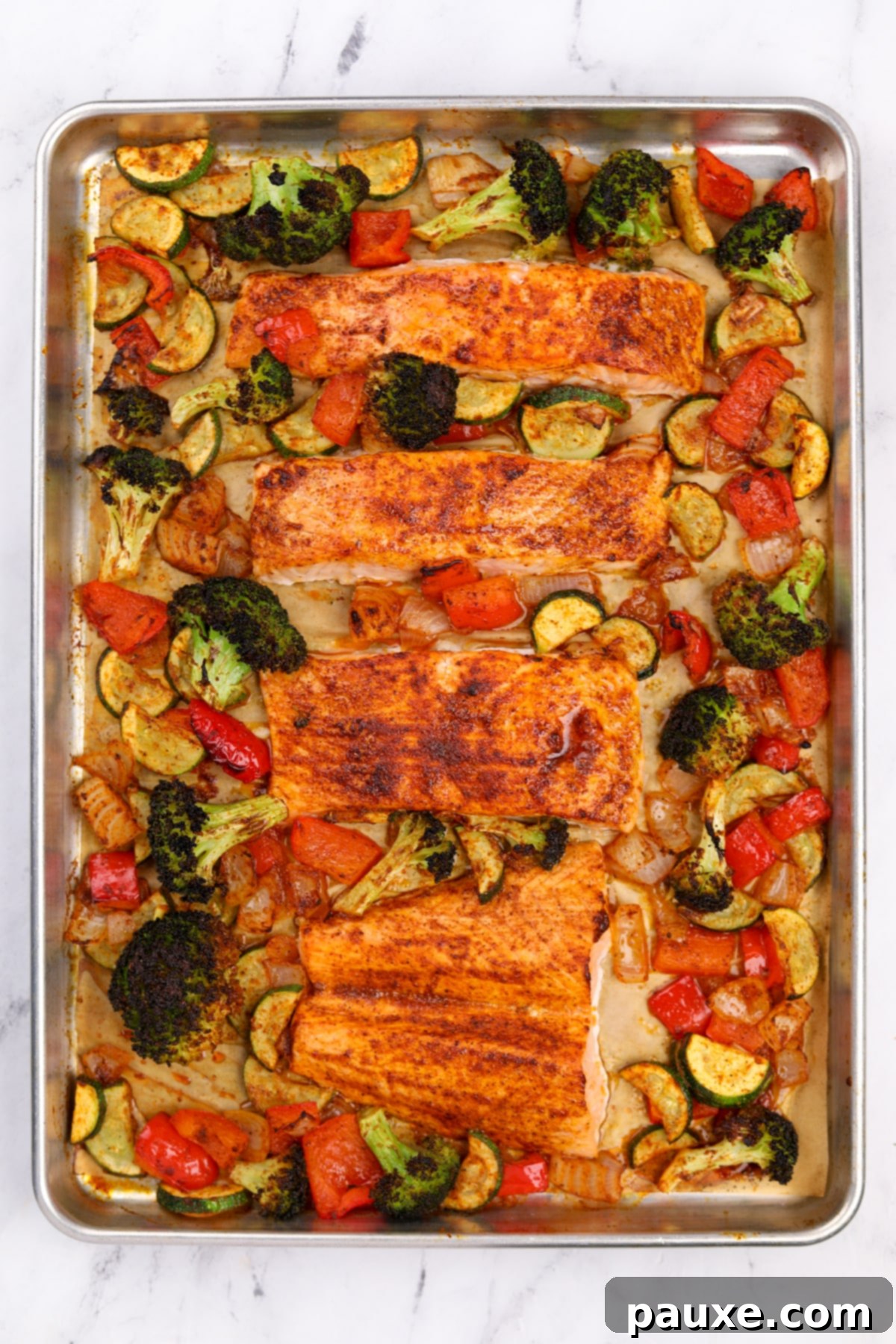
Step Six: Broil Until Done. Place the sheet pan in the preheated oven. Broil for 10-14 minutes, or until the thickest part of each salmon fillet reaches an internal temperature of at least 145ºF (63ºC). The vegetables should be tender-crisp and slightly charred in places. Cooking times may vary based on your oven and the thickness of your salmon, so keep a close eye on the dish, especially under a broiler. The salmon should flake easily with a fork when done.
Top Tip: For an extra burst of freshness and a beautiful presentation, consider adding a few thin slices of lemon to the sheet pan before or after baking. The heat will release their aromatic oils, infusing the dish with bright citrus notes.
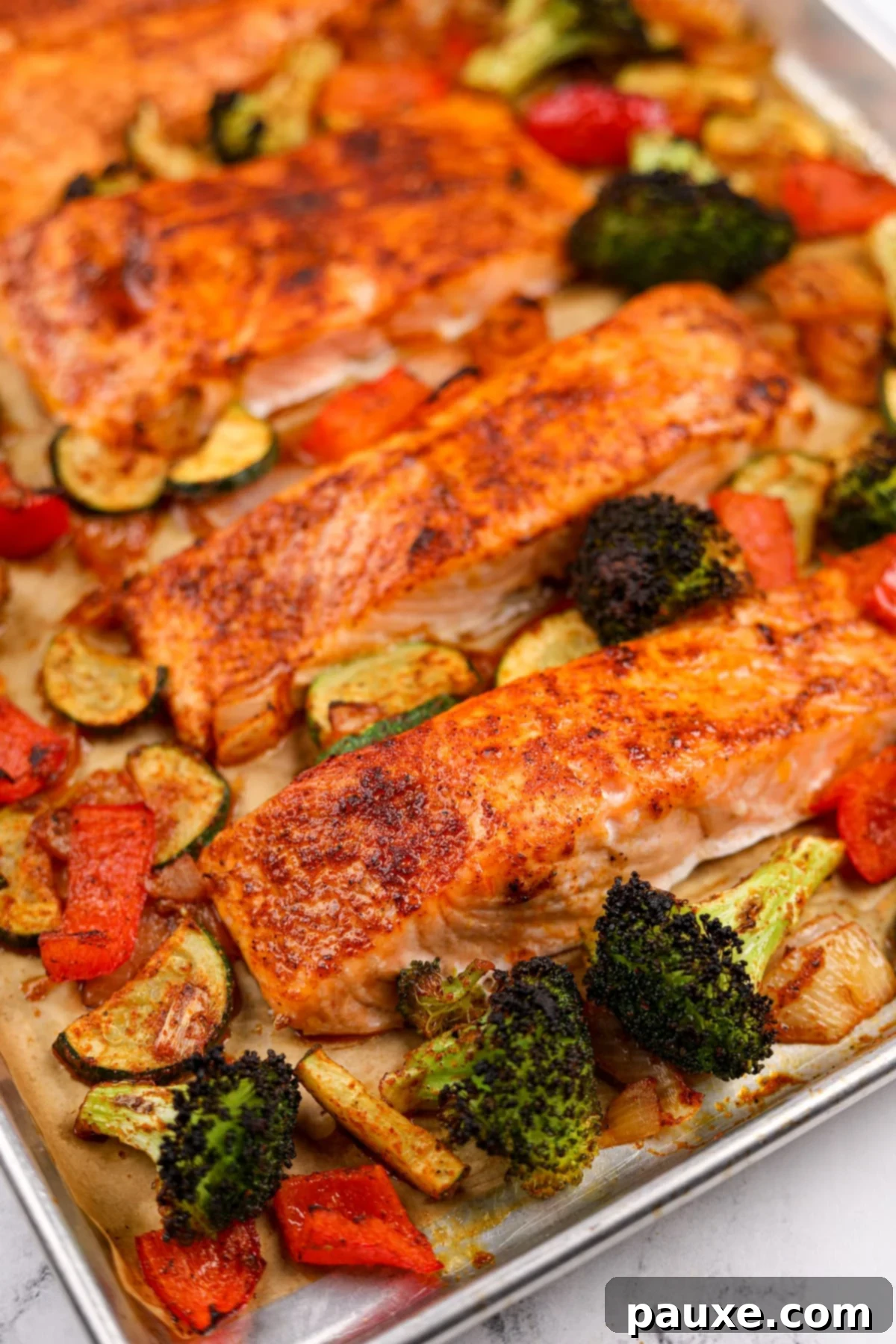
Air Fryer Instructions for Crispy Perfection
For those who love the crispiness an air fryer delivers, or simply prefer this cooking method, you can easily adapt this recipe. The air fryer offers a fantastic way to achieve perfectly cooked salmon and tender-crisp vegetables in even less time.
- Prepare the Salmon: Instead of leaving the fillets whole, slice your salmon into 1 ½-inch pieces. This allows for faster and more even cooking in the air fryer basket.
- Preheat: Begin by preheating your air fryer to 400ºF (204ºC) for at least 3 minutes. This ensures the air fryer is at the optimal temperature for cooking, leading to a better texture.
- Batch Cook: Due to the smaller capacity of most air fryers, it’s recommended to cook in batches. Add about half of the seasoned vegetables and salmon pieces to the air fryer basket, ensuring they are spread into a single layer. Overcrowding will steam the food rather than crisp it.
- Cook: Cook for approximately 10 minutes. Halfway through the cooking time (around the 5-minute mark), shake the basket gently and turn the salmon pieces to ensure even cooking and browning.
- Check Doneness: The salmon should be flaky and the vegetables tender. While an internal temperature of 125ºF (52ºC) indicates doneness, many prefer their fish cooked to 145ºF (63ºC) for a firmer texture. Always use a meat thermometer for accuracy.
- Repeat: Once the first batch is done, transfer it to a plate and repeat the cooking process with the remaining salmon and vegetables until everything is cooked to perfection.
Storing Leftovers & Smart Meal Prep Tips
This Sheet Pan Salmon and Veggies recipe is not only fantastic for immediate enjoyment but also makes for excellent leftovers and efficient meal prep. Planning ahead can save you valuable time during busy weekdays!
Storing Leftovers
Allow any cooked leftovers to cool completely to room temperature before transferring them to an airtight container. Store them in the refrigerator for up to 3 days. Beyond this, the quality of both the salmon and vegetables may start to diminish.
Reheating Instructions
There are a few ways to reheat your salmon and veggies, depending on your preference for texture:
- Microwave: For a quick reheat, place your portion in a microwave-safe dish and microwave on high for 1-2 minutes, or until thoroughly heated through. Be cautious not to overcook the salmon, as it can become dry.
- Air Fryer: To regain some of that lovely crisp texture, reheat in an air fryer set to 350ºF (177ºC) for 5-7 minutes, or until hot. This method is great for preventing soggy vegetables and keeping the salmon tender.
- Oven: For larger portions or if you prefer an oven reheat, preheat your oven to 300ºF (150ºC). Place the salmon and vegetables on a baking sheet, cover loosely with foil, and heat for 10-15 minutes, or until warmed through.
Meal Prep Excellence
This recipe is perfectly suited for meal prepping. On your designated prep day, cook a larger batch of salmon and vegetables. Once cooled, portion equal amounts into individual meal prep containers. If desired, add a serving of your favorite carb source alongside, such as cooked brown rice, quinoa, roasted potatoes, or even a low-carb cauliflower rice for a complete, grab-and-go meal throughout the week. This ensures you have healthy, delicious meals ready to go, saving you from last-minute cooking decisions.
Perfect Pairings: Elevate Your Meal
While this sheet pan salmon and veggies dish is incredibly satisfying on its own, especially as a light lunch, it truly shines when paired with complementary side dishes for a more substantial and hearty dinner. Here are some of our favorite recommendations to complete your meal:
- Fluffy Rice: Whether you prefer classic white rice, nutrient-dense brown rice, or a fragrant basmati, rice provides a comforting and absorbent base that soaks up all the delicious juices and seasonings from the salmon and vegetables.
- Cauliflower Rice: For a lighter, low-carb alternative, cauliflower rice is an excellent choice. It’s subtly flavored and adds a textural contrast without overwhelming the main dish.
- Hearty Quinoa: Packed with protein and fiber, quinoa is a fantastic, wholesome grain that adds a nutty flavor and chewy texture, making your meal even more fulfilling.
- Fresh Lettuce Bowl: For an ultra-light and refreshing option, serve your salmon and veggies over a bed of crisp mixed greens, perhaps with a drizzle of a light vinaigrette.
- Delicate Couscous: Couscous offers a quick-cooking, fine-grained option that can be seasoned simply and provides a delightful texture alongside the roasted components.
- Pasta: A simple pasta dish, perhaps tossed with a light lemon-garlic sauce or just a touch of olive oil and herbs, makes for a delicious and more filling dinner option.
- Roasted or Mashed Potatoes: The classic comfort of roasted potatoes or creamy mashed potatoes provides a hearty and satisfying starch that pairs wonderfully with the savory salmon and tender vegetables.
- Roasted Radishes: If you’re looking for a low-carb, unique side, roasted radishes soften and sweeten significantly when cooked, offering a surprising depth of flavor.
- Baby Potatoes: Small, tender baby potatoes can be roasted right alongside your other vegetables if cut small enough, or prepared separately and seasoned simply.
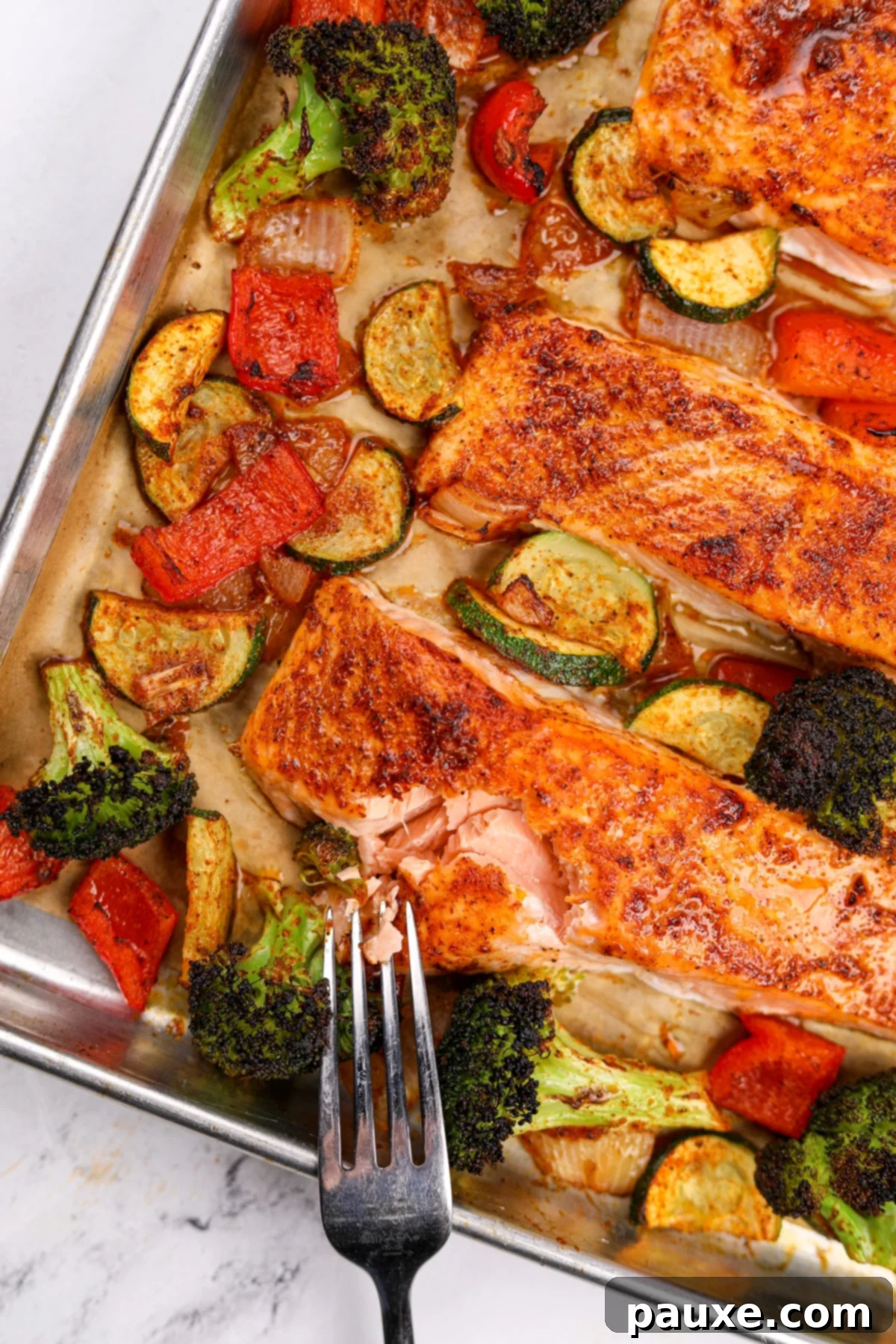
Creative Culinary Twists: Endless Variations
The beauty of sheet pan meals lies in their incredible flexibility. Once you master the basic technique, the possibilities for customization are virtually endless. Here are some exciting variations to keep your meals fresh and exciting:
- Sweet Potatoes and Green Beans: Transform your vegetable medley by swapping the suggested vegetables for about 4-5 cups of small, 1-inch cubed sweet potatoes and an equal amount of fresh green beans. Sweet potatoes take slightly longer to cook, so cut them small or consider pre-roasting them for about 10-15 minutes before adding the salmon and green beans.
- Zesty Lemon Pepper: For a bright and tangy kick, replace the individual seasonings (paprika, garlic powder, salt, and pepper) with an equal amount of your favorite lemon pepper seasoning blend. This simplifies the spice rack and delivers a cohesive, citrusy flavor profile.
- Chicken and Vegetables: Not a fan of fish, or just craving something different? Substitute the salmon fillets with approximately 1 pound of boneless, skinless chicken breasts or thighs. For optimal cooking consistency with the vegetables, I recommend cutting the chicken into 1 ½-inch pieces. You may also want to marinate the chicken for an extra 15-30 minutes for enhanced flavor.
- Shrimp and Vegetables: For a super-fast cooking protein, opt for 1 to 1 ½ pounds of medium-large peeled and deveined shrimp in place of the salmon. Shrimp cooks very quickly, typically in 5-8 minutes, so add it to the pan during the last 5-7 minutes of the vegetable cooking time to prevent overcooking.
- Savory Beef and Veggies: Embrace a heartier option by trading the salmon for 1 to 1 ½ pounds of finely sliced beef strips, similar to those used in stir-fries. Toss the beef strips with the seasoning and oil, and ensure they are spread in a single layer for proper searing.
- Umami-Rich Soy Sauce Addition: For an extra layer of savory flavor and umami depth, consider adding 1-2 tablespoons of low-sodium soy sauce, tamari (for gluten-free), or coconut aminos to your olive oil and seasoning blend. This creates a more Asian-inspired flavor profile that pairs beautifully with the roasted elements.
- Mediterranean Twist: Add chopped artichoke hearts, Kalamata olives, and cherry tomatoes to your vegetable mix. A sprinkle of feta cheese after cooking would complete this vibrant flavor profile.
Tailoring for Dietary Needs
This Sheet Pan Salmon and Veggies recipe is already wonderfully adaptable and caters to several common dietary requirements, making it a versatile choice for almost everyone. Here’s how to further fine-tune it:
- Low Carb/Keto: This recipe is inherently low carb, boasting just 8 net carbs per serving as written. To reduce the carbohydrate count even further, you can easily substitute the onion and bell pepper—which contain a moderate amount of carbs—with very low-carb vegetables such as asparagus, green beans, mushrooms, spinach (added during the last few minutes of cooking), or additional yellow squash. This will allow you to enjoy a flavorful and satisfying meal while strictly adhering to a ketogenic diet.
- Dairy-Free: You’re in luck! This recipe is naturally dairy-free, requiring no modifications whatsoever. Enjoy without worry!
- Gluten-Free: Good news for those with gluten sensitivities or celiac disease: this recipe is naturally gluten-free as well! All the ingredients specified are free from gluten, so there’s no need to make any changes to enjoy this delicious meal. Always double-check labels on any pre-packaged seasonings or ingredients to ensure they are certified gluten-free, especially if you have severe sensitivities.
- Nut-Free: The recipe as written is also nut-free. Always check labels on any prepared seasoning blends to ensure no hidden nut ingredients if allergies are severe.
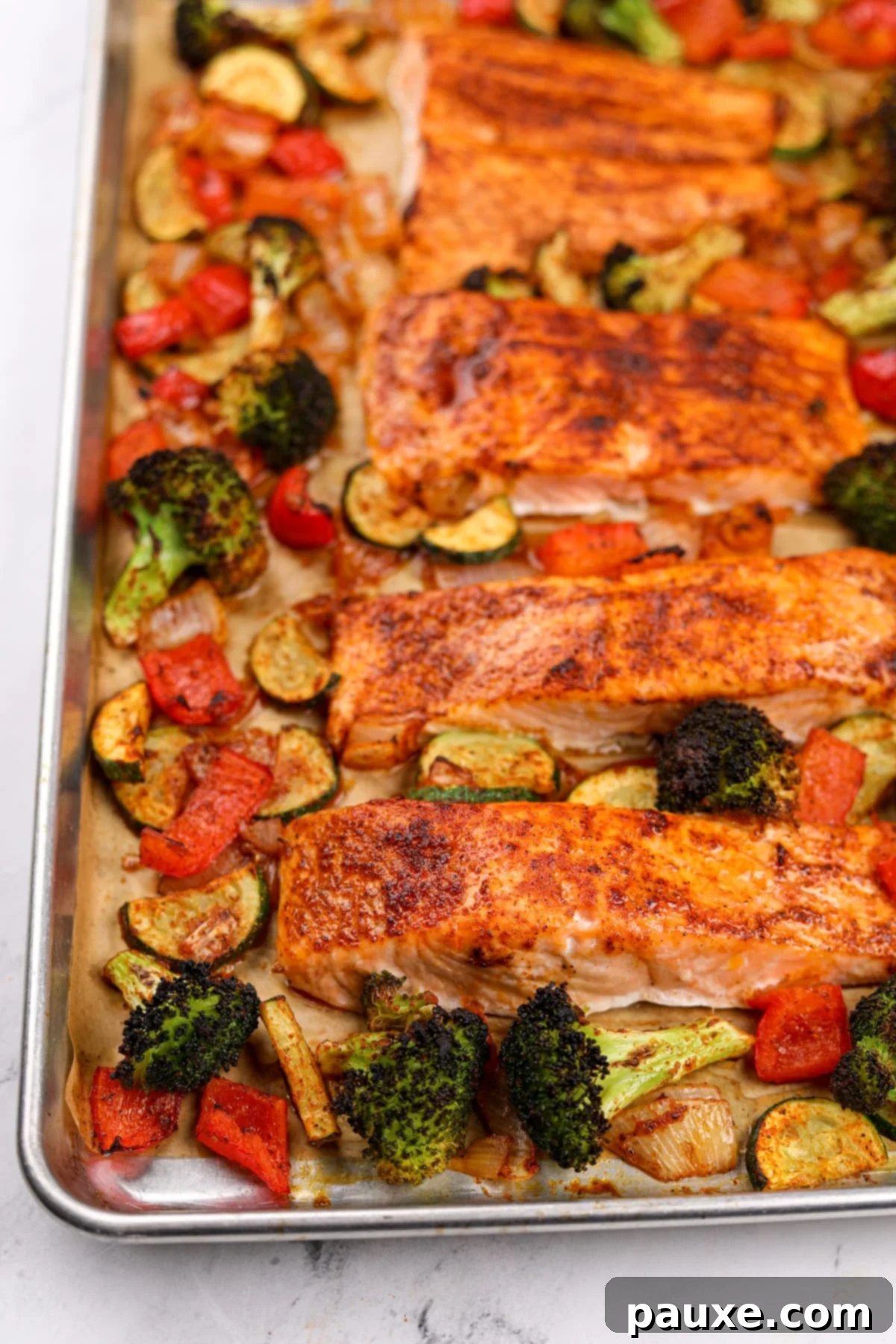
Recipe FAQs: Your Questions Answered
- Can I use frozen salmon for this recipe?
- While you can certainly use frozen salmon, it is highly recommended that you thaw it completely before starting the recipe. Placing frozen salmon directly on the sheet pan with fresh vegetables will result in uneven cooking. The vegetables will cook much faster and likely become overcooked or mushy, while the salmon remains undercooked in the center. For best results, thaw frozen salmon in the refrigerator overnight (8-12 hours) or under cold running water for 30-60 minutes, then pat it dry before seasoning.
- What size salmon fillets work best?
- For optimal and consistent cooking results, we recommend using pre-cut salmon fillets that are typically around 6 ounces each. Fillets that are slightly smaller or larger than this are perfectly fine, but you may need to adjust the cooking time accordingly. Thicker fillets will require a few extra minutes, while thinner ones will cook faster. Aim for pieces that are roughly the same thickness to ensure they all finish cooking at the same time.
- Can I use aluminum foil instead of parchment paper?
- Absolutely! If you don’t have parchment paper on hand, heavy-duty aluminum foil is a suitable alternative for lining your sheet pan. To prevent any sticking, especially with the delicate salmon, we highly recommend spraying the foil generously with cooking spray or brushing it with a thin layer of olive oil before arranging your ingredients. You can also crimp the edges of the foil around the pan to create a slight barrier, preventing any juices from escaping.
- How can I prevent my salmon from drying out?
- The key to juicy, flaky salmon is not to overcook it. Salmon is done when it reaches an internal temperature of 145ºF (63ºC) at its thickest part. Using an instant-read meat thermometer is the most reliable way to check for doneness. Also, ensure your oven is preheated properly and avoid cutting into the salmon while it’s cooking, as this can release juices. The broiler setting cooks quickly, so keep a close watch!
- Can I use different vegetables?
- Yes, absolutely! This recipe is incredibly versatile. Feel free to substitute the broccoli, bell pepper, and zucchini with other quick-cooking vegetables like asparagus spears, green beans, cherry tomatoes, sliced mushrooms, or even thin slices of sweet potato (which might require a few extra minutes of cooking or smaller cuts). The most important tip is to cut all vegetables into similar sizes so they cook evenly.
Explore More Easy Sheet Pan Dinners:
If you’ve fallen in love with the convenience and deliciousness of this sheet pan meal, you’ll be thrilled to discover more recipes that offer the same ease and flavor:
- Cilantro Lime Salmon
- Smoked Sausage and Peppers
- Lemon Garlic Chicken Thighs – Carlsbad Cravings
- Beef and Broccoli – Averie Cooks
- Sheet Pan Roasted Chicken, Sweet Potatoes, and Broccoli – Gimme Delicious
More Easy & Healthy Dinner Recipes:
- Air Fryer Chicken and Vegetables
- Air Fryer Salmon Bites
- La Scala Chopped Salad
- Inside Out Egg Roll in a Bowl
We truly hope you enjoy this fantastic recipe for Sheet Pan Salmon and Veggies! If you loved it, please consider leaving a 5-star review in the comments below to help other home cooks discover this easy meal. You can also share your creations and tag us on Instagram @dashfordinner. Your feedback and photos make our day!
Sheet Pan Salmon and Veggies
This easy Sheet Pan Salmon and Veggies recipe is made with pre-cut salmon fillets, broccoli, bell pepper, and zucchini, offering a quick and healthy dinner solution.
Average Rating: 4.50 from 4 votes
Print Recipe | Pin Recipe
Course: Dinner, Lunch, Main Course, Main Dishes
Cuisine: American
Prep Time: 10 minutes
Cook Time: 14 minutes
Total Time: 24 minutes
Servings: 4 servings
Calories: 384 kcal
Author: Dorothy Bigelow
Equipment
- Sheet Pan
Ingredients
- 4 salmon fillets (thawed if frozen, approximately 1-1 ½ pounds)
- 1 red bell pepper (seeded and chopped)
- 1 small zucchini (cut into half-moons)
- 1 small onion (peeled and roughly chopped)
- 2 cups broccoli florets (approximately 1 bunch)
- 3 tablespoons olive oil
- 1 tablespoon lemon juice
- 1 ½ teaspoons garlic powder
- 1 ½ teaspoons paprika
- ¾ teaspoon salt
- ½ teaspoon ground black pepper
Instructions
- Line a broiler-safe sheet pan with parchment paper* and preheat the oven to the broil setting on high heat.
- Place the salmon fillets skin side down on the lined baking sheet, spacing them out evenly. Set aside.
- Add the olive oil, lemon juice, garlic powder, paprika, salt, and black pepper to a large bowl. Whisk well until the seasonings are well combined with the lemon juice and olive oil.

- Use a pastry brush to spread about half of the seasoned oil on the salmon pieces.

- Add the bell pepper, zucchini, onion, and broccoli to the bowl with the remaining seasoned oil, and toss to coat the vegetables in the seasoning and oil.

- Transfer the seasoned vegetables to the baking sheet, spreading them out in between the pieces of salmon, and into an even layer.

- Broil in the preheated oven for 10-14 minutes, or until the thickest part of each salmon fillet reaches a minimum internal temperature of 145ºF (63ºC).

- After the salmon is cooked through and flakes easily with a fork, serve immediately along with some of the roasted vegetables and your favorite side dishes (rice, pasta, cauliflower rice, etc).

Notes
- Adapted from Air Fryer Chicken and Vegetables
- Air fryer: Working in half-sized batches, cook in a 400ºF (204ºC) air fryer for 10 minutes, or until the appropriate internal temperature is reached. Repeat for remaining batches.
- Frozen Salmon: If using frozen salmon, be sure to thaw it beforehand. This will take 3-5 hours at room temperature, or overnight (8-12 hours) in the refrigerator.
- Size and cooking time: Smaller fillets will cook more quickly, while larger (or thicker) ones will take a little more time. The best way to know if they are done is by checking the internal temperature.
- Internal temperature: Salmon is cooked through when it reaches a minimum internal temperature of 125ºF (52ºC), although many are more comfortable cooking it to 145ºF (63ºC) for a firmer texture.
- *Note about parchment paper: While parchment paper is generally for lower heat, it performs well under the broiler when completely covered by food and trimmed to fit the pan, preventing lifted edges. If you prefer, use aluminum foil that has been sprayed with cooking spray.
Nutrition
Calories: 384kcal | Carbohydrates: 11g | Protein: 37g | Fat: 22g | Saturated Fat: 3g | Polyunsaturated Fat: 6g | Monounsaturated Fat: 11g | Cholesterol: 94mg | Sodium: 534mg | Potassium: 1245mg | Fiber: 3g | Sugar: 5g | Vitamin A: 1752IU | Vitamin C: 91mg | Calcium: 62mg | Iron: 2mg
Please note that some of my blog posts here at Dash for Dinner may contain affiliate links. If you make a purchase through these links, I will get a small commission at no additional cost to you. Please see my Disclaimer for more information.
